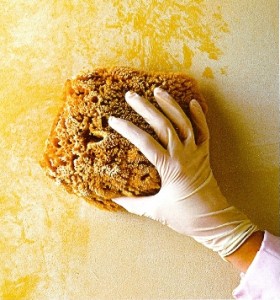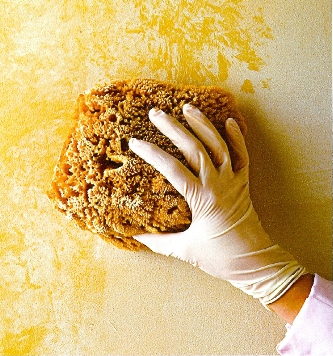When it comes to achieving a true rustic looking antique finish, the most important thing you can remember is “experiment”…….. There are so many variables when trying to mimic an old look, that your best bet is to give yourself a lot of time…… don’t rush it. The more samples and experiments you do, the better your end product is going to be. Make what mistakes you’re going to mak e on your samples…… not the main item to be paint.
e on your samples…… not the main item to be paint.
The variables I mentioned can range from the obvious like application, sometimes with a brush, sometimes with a sponge, and even sometimes with a rag or the individual grade of paint…… the viscosity (thickness), water or oil base. But then the obscure can be your worst enemy. For instance, the temperature and humidity. Higher temperatures will dry paint faster. Sometimes the paint will set-up so fast, you won’t have time to do washes or wipe offs, and if you do too large of a section before you start the rubbing, you once again will encounter paint that has already started to dry. The other variable will be the humidity. Rain can radically alter the drying time and you may find it taking far long than you’d expected for the paint to set-up.
Because all faux’ finishes strive to mimic the authentic age of weathered or distressed piece of furniture, you won’t be dealing in “exacts”……. like you would with a fresh new finish. The slightest thing can alter the entire outcome of a Faux’ finish. Given the same tools and same paint, two painters will rarely come up with the same “finish”, after all the steps are taken.
Finesse is your friend, when doing faux’ finishes. Different strokes of the brush can give you different effects and also alter the next layer or wash that goes on top of it.
A prime example of “finesse” when creating a faux’ finish, is the manner in which “glue” is applied to a piece of furniture. Glue is used to give a finish a “crackled” effect. But consider all the different “types” and sizes of crackle you’ve seen. The are small minute “spider” crackles and then there are very even uniform crackles or even large open bold crackles. The type of crackle is dependent on the stroke or application and also the temperature. Here again, I can’t stress experimenting enough. If you’re working outside one day and getting the perfect crackle you want and then the next day it seems to be entirely different…… consider all the variables that are in play…. temperature, cloud cover, humidity, even slight winds can make a difference in the drying time. If you have the luxury of an indoor work room with controlled heat and humidity, you’ll be more apt to be able to recreate a particular finish more than once.
Before starting any finish you’re going to want to apply a coat of primer. Primers are important to the success of a finish. For example, if you’re doing an iron bed, you’re going to need a good strong metal primer that will bond with the metal. If your metal has been sandblasted, be sure and wipe off all the dust or the primer won’t hold if you use a crackle gluing layer. Cheap metal spray primers will leave you having to start your finish all over again, because once the finish dries and constricts, it will start pulling itself right off the metal. So do yourself a favor and find a good “brush on” metal primer”. If you’re antique is wood, your primer should be appropriate for wood. Primers come in a number of colors. Primarily black, white , grey, Terra Cotta, and a few other colors. Be sure and select a color that you may end up rubbing down to through the other top coats you’ll be applying.
Your next coat will be your main base color, and it can be literally anything. Once you’ve applied a good solid coat, you may want to chip it up a little with either a putty knife or by using a dam acetone rag. Try both methods to see which one gives you the desired look.
If you’re looking for a slightly aged look without a lot of time and effort, try a simple wash using a Raw Umber Acrylic. Use a dry brush and paint the acrylic over whatever the base color of your antique happens to be. Be sure to do small sections, so the acrylic doesn’t have an opportunity to dry. As soon as you paint it on, use either a paper towel or an old terry cloth rag, rub in and wipe off the acrylic. You notice that your base color has taken on an older look. Here again, I can’t emphasize enough with experimenting with how much you need to rub in and off of the acrylic. To achieve a slightly rusted effect, try rubbing in Burnt Umber and Raw Sienna. With each of these acrylics you’ll want to try doing samples with slight sponge application. Simple light blotching of either or both acrylics will give you an irregular rusted effect. You may find that after applying these two acrylics, a final wash of Raw Umber will give a natural aged effect.
Antique Faux’ finishes are endless. A good pointer to follow is to write down each separate step so you’ll remember how you achieved your final look. There’s nothing worse that doing a multiple layered finish with a number of different applications, only to find out you’ve forgotten the steps you took to get where you want the finish to end up.







